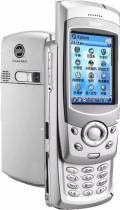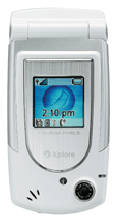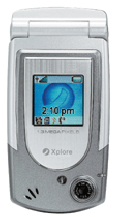Group Sense PDA
Company History
Group Sense Ltd. (GSL) was an international company, founded in Hong Kong in June 1988.
Early days (1988~2000)
Before the rise or PDAs and smartphones Group Sense's main businesses included:
- Translation dictionaries, branded as “Instant Dict” (快譯通) in Hong Kong and Taiwan), and as “快译通” in China, which translates as “Express Translation”
- ODM Designs and Manufacturing electronic dictionaries for the Japanese market (1990s to 2010s)
- Pager devices 小灵通 based on the Japan PHS system (1990s to early 2000s).
PDA Era (2000-2002) After 2000, the company faced new challenges, with the pager business in decline due to the rise of SMS, and with new competition arising in the PDA market from other Chinese companies.
On 4 September 2000, the business restructured into three divisions; Electronic Dictionaries, PDAs & Smartphones, and ODM services. In May 2001, a join venture was formed between GSL, Intel, SB China (Softbank subsidiary) and UTStarcom to develop devices for the PDA market.[14] The PDA division was named Group Sense PDA Limited (GSPDA).
In 2001, GSL released their Xplore V series of PDA. The first model, the V88, came with 8MB RAM, and had the appearance of a typical PDA of the time.
The company envisioned that wireless-data enabled PDAs would be popular in the future, and in their annual report they explicitly indicated that this market would be a primary focus going forwards. In October 2001, the i-Xplore 938, was announced and shown to the press. This was a Bi-lingual PDA with integrated GSM mobile connectivity, and featured an in-house developed proprietary OS [2]. i-Xplorer938 e968 early smartphones
Smartphone Era (2002-2007)
In late 2002, GSPDA signed a licensing agreement with PalmSource for permission to develop Palm OS PDA's [1], with 5 Palm OS devices eventually developed. The license was initially only for devices to be marketed to the Asia/Pacific market [10], before they later pursued a full ODM license with worldwide distribution rights [11].
During this period, a new Xplore was being developed and released yearly.
A flip cover device codename “Onyx” was reportedly being developed in 2001-2002, with the design of this device appearing similar to the original GSM PDA series, and unlike the later Palm-OS based Xplore series. However, this device was axed eventually before release.
GSPDA were also in development on possibilities of other operating systems. v2002 Linux PDA's
The Singapore branch of GSPDA incorporated as a subsidiary called “Group Sense Technology (Singapore) Pte Ltd.”, before renaming as Oswin Technology PLin 2004, when they began trading as Oswin Technology, eventually moving to a newown domain name in Nov 2004.
In early 2005, an Oswin device running Palm OS 6.1 (“Cobalt”) was show to the press and demoed [25], and it appeared likely that this would be the first Cobalt-based device to ship[17].
However, with the sacking of the PalmSource CEO in mid-2005, and the sale of PalmSource to ACCESS in late 2005, it appeared that Palm-OS 6.1 would be cancelled. In response, in 2006 GSPDA announced that they would continue to ship new devices with PalmOS 5.4, such as the Xplore M70 (announced Sep '06), alongside a second series of smartphones running a newJava-based OS developed by company SavaJe. The first new device announced with this Java OS was the Jasper S20 (shown right), for future release in 2007.
However, by 2007, the Xplore M70 international release was canceled, while plans for the Jasper S20 were disrupted with financial troubles at SavaJe, seeing them acquired by Sun in April 2007. In 2008, the GSPDA joint-venture were closed, the Xplore brand and website was retired, and the Palm-OS device lineup was depreciated. In-place of this, a new brand called Group Sense Mobile-Tech Ltd. (GSML) was created, initially producing GPS units and VOIP handsets, and later focusing on point-of-sale (POS) PDAs and systems.
Xplore Smartphones
In total, six Xplore Smartphones were developed by GSPDA.
Initially, GSPDA announced two models, a candybar model “Zircon Z3”, and a clamshell model “Onyx” [12][13]. The Zircon model was released in July 2003, renamed as the Xplore G18, while the Onyx was promised for later release in Q3 2003. However, the Onyx release did not eventuate, and in early 2004 was quietly removed from the GSPDA website. Photos of the Onyx device are on the right.
Common Features:
- GSM only
- 160×220 LCD
Palm OS 4.1
- G18 - July 2003, Candybar touchscreen phone, CIF Camera, 16MB, codenamed “Zircon”.
- “Onyx” - Slated for 2003Q3, but was cancelled. Clamshell, CIF Camera (see photos on right column)
- G88 - 2004, Candybar slider phone, 48MB, CIF Camera, codenamed Zircon I
Palm OS 5.4
- M28 - Candybar slider phone, VGA Camera, codenamed Zircon II
- M98 - Clamshell, 1.3MP Camera, Micro-SD expansion, 96×96 external screen, codenamed Onyx II [4]
- M68 - Candybar, 1.3MP Camera, SD expansion, bluetooth ($699SGD / $430USD)
- M70 - Candybar, 1.3MP Camera, SD expansion, bluetooth
Palm OS 6
- Codename Oswin Z
G18
 “The smallest Palm OS® Smartphone in the world”
Launched July 2003 in Asia, Q3 in EU.
Sold over 100,000 units[15].
“The smallest Palm OS® Smartphone in the world”
Launched July 2003 in Asia, Q3 in EU.
Sold over 100,000 units[15].
- Codename Zircon, HAL ID zicn, Device ID zicn
- The Xplore G18 was sold in Singapore as the Zircon Z3.
- Sold in Germany through Quelle as the Universum Xplore G18.
- Also know as X-PRO P168 in Taiwan
Specifications
- Phone features: Dual band 900MHz and 1800MHz, GPRS Class 10
- Support services: E-book, E-mail, WAP, SMS, MMS, STK, Java, etc.
- Organizer: Address, Date book, Memo, To-do, etc.
- Entertainment: Camera, formats, games, photo album, etc
- Input: Virtual keyboard input, Graffiti hand-writing recognition
- PC Sync: Synchronization with PC
- Conectivity: IrDA 1.2
- Others: Calendar, Calculator, Timer, etc.
- OS: Palm OS® 4.1
- Main Processor: Motorola Dragonball Vz 33MHz
- Memory: MaskRom - 16M Bytes, SDRAM - 16M Bytes, Flash - 4M Bytes
- LCD: 176 x 240 pixels, 256K color, 2.2“ D-TFD color LCD + touch panel (display color subject to software support)
- Camera: CIF (352 x 288)
- Battery: 850 mAH Lithium-Polymer (removable)
- Battery Life: GSM Talk Time (2 hours), GSM standby time (100 hours)
- Weigh: 105g (approx.)
- Unit Size: 48 x 100 x 21 mm
G88
 Announced Feb 2004 as update to G18.
Promoted as “Still the smallest Palm Powered Phone”.
https://www.geekzone.co.nz/content.asp?contentid=2375
Announced Feb 2004 as update to G18.
Promoted as “Still the smallest Palm Powered Phone”.
https://www.geekzone.co.nz/content.asp?contentid=2375
- Codename Zircon I, HAL ID zicn, Device ID zicn [22]
- Also known as Zircon G88 in Singapore
Specifications
- Phone features: Dual band 900MHz and 1800MHz, GPRS Class 10
- Support services: E-book, E-mail, WAP, SMS, MMS, STK, Java, etc
- Organizer: Address,Date book, Memo, To-do, etc.
- Entertainment: Camera, formats, games, photo album, etc 70,000 words English -chinese Dictionary, 50,000 Chinese-english dictionary keyboard input, Graffiti hand-writing recognition
- USB PC Sync: Synchronization with PC
- Conectivity: IrDA 1.2 Others: Calendar, Calculator, Timer,etc.
- OS : Palm OS 4.1.2
- Main Processor : Motorola Dragonball Vz 33MHz
- memory: MaskRom - 16M Bytes, SDRAM - 16M Bytes, Flash - 4M Bytes in-built 24MB Flash Memory
- LCD: 176 x 240 pixels, 256K color, 2.2” D-TFD color LCD + touch panel (display color subject to software support)
- Camera: CIF (352 x 288)
- Battery: 850 mAH Lithium-Polymer (removable)
- Battery life: GSM Talk Time (2 hours), GSM standby time (100 hours)
- weight: :105g (approx.)
- Unit Size: :48 x 100 x 21 mm
- Network dependent features may require relevant subscription service
M28
- Codename Zircon II, HAL ID zcn2, Device ID zcn2 [22]
Specifications
- 2.2” 260,000 colors TFT touch panel LCD Display
- Video recording & playing function
- MP3 player & Voice recorder
- VGA Digital camera with zoom & multi-shot function
- Email support POP3, SMTP with attachment
- View and edit attachment function (in conjunction with application software)
- Full screen Chinese & English handwriting recognition input
- 32MB M-systems built-in memory
- External SD/MMC memory card expansion slot
- 40 polyphonic ringtones support MIDI & MP3 format
- Support GPRS Class 10, xHTML, WAP2.0, MMS, SMS*
- Built-in exciting Palm games
- Built-in English to Chinese dictionary
- Data transmission through IrDA
- Synchronize your data to your PC
- Palm OS 5.4
- CPU: Arm 9
- Battery life: Talk time up to: 3.5 hrs; Stand by time: 170 hrs
- Dimension: 106mm x 50.8mm x 23.5mm; 130.5mm x 50.8mm x 23.5mm (Slide up)
- Weight: 132g (including battery and stylus)
- Network dependent features may require relevant subscription service
- Specifications, accessories, features and download content are subject to change without prior notice
M68
First Xplore phone with Bluetooth. Ann. Feb 2005, rel, early 2006
- Sold in UK as Hagenuk S200.
- Sold in Italy as Xplore M68.
- Codename Unknown, HAL ID zcn5, Device ID zcn5 [22]
[5][6][8]
Specifications
- Size & Weight: 49.5 x 109 x 22.5 mm (1.9 x 4.3 x .88 Inches); 127g (4.48 oz)
- Processor: ARM 9 OMAP 168 Mhz
- Operating System: Palm OS Garnet v5.4
- Memory: 32 MB RAM / 64 SDRAM flash memory
- Expansion: SD/MMC memory slot
- Screen: 176×220 pixel (only 160×220 used) ; 2.2 inch, 65k-color; transflective (D-TFD)
- Audio: 2.5mm headset jack; rear speaker
- Power: Rechargable Li-Ion Poly, 1350 mAh (4 hrs talk/170 hours standby)
- Connectivity: Tri-Band GSM radio (900/1800/1900), Class 10 GPRS,
- HotSync-Connector, IrDA, Bluetooth (v1.1)
- Exciting Palm games included: Bejeweled, Book Worm, GTS Racing, Megabowling, Zap! 2016
Features
- GSM 900/ 1800/ 1900MHz
- Palm OS® 5.4 Garnet
- Display: 260K Color, 2.2”TFT, LCD Touch Screen
- Instant email with one touch only
- Bluetooth Synchronization
- SMS Alarm
- Video caller ID
- Full screen writing input, support both Chinese and English
- 1.3 mega pixels camera, with digital zoom and multi-shot function
- Video viewing and recording function
- MP3 playing and recording function
- 40 poly ringtone support MIDI and MP3 format
- Email support (POP3, SMTP) with viewing and editing attachment function
- (in conjunction with application software)
- Support GPRS Class 10/ xHTML, WAP2.0, MMS, SMS
- External SD memory card expansion slot
- Bluetooth, Infrared and USB connectivity
- Exciting Palm game
* Subject to local network service and usage conditions
Accessories
- Battery
- Traveler charger
- Stylus
- Stereo Handset
- USB PC synchronize cable
- Download software
Specification
- CPU: Arm 9
- Dimension: 49.5 x 109 x 22.5 mm
- Weight: 129g
- Talk time: Up to 240mins
- Stand by time: Up to 170hours
M98
- Announced Feb 2005, Released in Aug 2005, and discontinued in Sept 2006 [4]
- Attractively priced, but poorly marketed [7]
- Sold as XPRO P368 in China.
- Codename Onyx II, HAL ID UNKNWON, Device ID UNKNOWN [22]
Specifications
- GSM 900/ 1800/ 1900MHz
- Toggle between Phone mode and PDA mode by one touch only
- Full screen writing input, support both Chinese and English
- Video caller ID, SMS Alarm
- 1.3 mega pixels camera, with digital zoom and multi-shot function
- Video viewing and recording function
- MP3 playing and recording function
- 40 poly ringtone support MIDI and MP3 format
- Email support (POP3, SMTP) with viewing and editing attachment function (in conjunction with application software)
- Support GPRS Class 10/ xHTML, WAP2.0, MMS, SMS
- External TransFlash memory card expansion slot
- Infrared and USB connectivity
- Exciting Palm games included: Bejeweled, Book Worm, GTS Racing, Megabowling, Zap! 2016
- Palm OS® 5.4 Garnet
- Display: External – 260K Color, TFT 96 x 96 pixels resolution
- Internal – 260K Color, TFT 176 x 220 pixels resolution
- CPU: Arm 9
- Talk time up to: 2 hrs
- Stand by time: 100 hrs
- Comes in white, orange, or silver
- Dimension: 95.5 x 46.8 x 25.5 mm
- Weight: 109g
- Specifications, accessories, features and download content are subject to change without prior
- notice
- Subject to local network service and usage conditions
M70
Almost identical to the M68. Ann. Sept 2006, rel, early 2006
- Codename UNKNOWN, HAL ID zcn5, Device ID zcn5 [22]
A minor update, the M70S was later released in Oct 2007 with a firmware update.
Specifications
Features
- Tri band: GSM 900/ 1800/ 1900MHz
- Palm OS® 5.4 Garnet
- Display: 260K Color, 2.2” TFT 176 x 220 pixels, touch screen
- Push Email
- One touch Email function
- Bluetooth communication and synchronization
- SMS Alarm
- Video Caller Display
- Full screen Chinese and English handwriting input
- 1.3 mega pixels CMOS camera, with digital zoom function
- Video recording and playback (support MPEG 4 and 3GPP format)
- MP3 ringtone and playback
- 40 poly ringtone, support MIDI and MP3 format
- Email support (POP3, SMTP) with viewing and editing attachment function (in conjunction with application software)
- Support GPRS Class 10/ xHTML/ WAP 2.0/ MMS/ SMS
- External SD card expansion slot
- Bluetooth, Infrared and USB connectivity
- Exciting Palm games
- Network dependent features may require relevant subscription service
Accessories
- Li-Polymer battery
- Traveller adaptor
- Stylus
- Handsfree
- USB sync cable
- Download software
Specification
- Processor : ARM 9
- Dimension : 109 x 50 x 23.7 mm
- Weight : 131g
- Talk time : Up to 240 mins*
- Standby time: Up to 170 hrs*
- Subject to local network service and usage conditions
- Specification, accessories, features and download content are subject to change without prior notice
Oswin Zircon Axia A108
The Axia A108 was announced in Nov 2004, but discontinued by 2006. It was launched under the brand name Axia, separate from the Xplore devices. It was also sold under the Zircon brand name, as the Zircon Axia A108 [26].
http://tech.sina.com.cn/mobile/n/2005-05-19/1742612387.shtml
. This device was advertised as "The world's smallest PDA Phone on Win CE .NET OS"., in a similar fashion to the Xplore devices.
In Feb 2005, at a local GSPDA public meeting, a representative indicated that GSPDA indicated to release a Palm OS 6 (Cobalt) based smartphone by the end of 2006[16] - over a year after Cobalt 6.1 was announced in 2004[17], and almost two years after Cobalt 6 was announced in Feb 2004.
In April it was indicated that the Oswin Axia A108 device would be available with a range of different OS platforms, including Palm OS 6 Cobalt [18][19].
These plans were again confirmed in May 2005, during an interview with PalmSource exectutives.
Finally, in late May, a prototype device running Cobalt 6.1.1 was shown at the PalmSource DevCon [20][21].
However, after this date, no news was heard about the Cobalt version of the Axia, and the launch never materialised.
Additional Photos provided by Dmitry Grinberg (creator of Palm Powerups) :
Specifications
- Procesor: Freescale iMX.21 (ARM)
- RAM: 64MB
- Displey: 2.2“, 320 x 240 pixel
- Camera: 1.3MPix
- Mobile: GSM TriBand 900/1800/1900MHz
- Data: GPRS Class 10
- MiniSD expansion
Other Cobalt OswinTech Devices
Revealed in Brochure provided by MobileRead
GroupSense Phone Slow? Disable the network GSM modem:
- Open phone app
- Click the centre button
- Click GSM on/off –> Turn GSM off –> Confirm
- It will try to reconnect –> press Cancel
- Device speed should be restored.


























